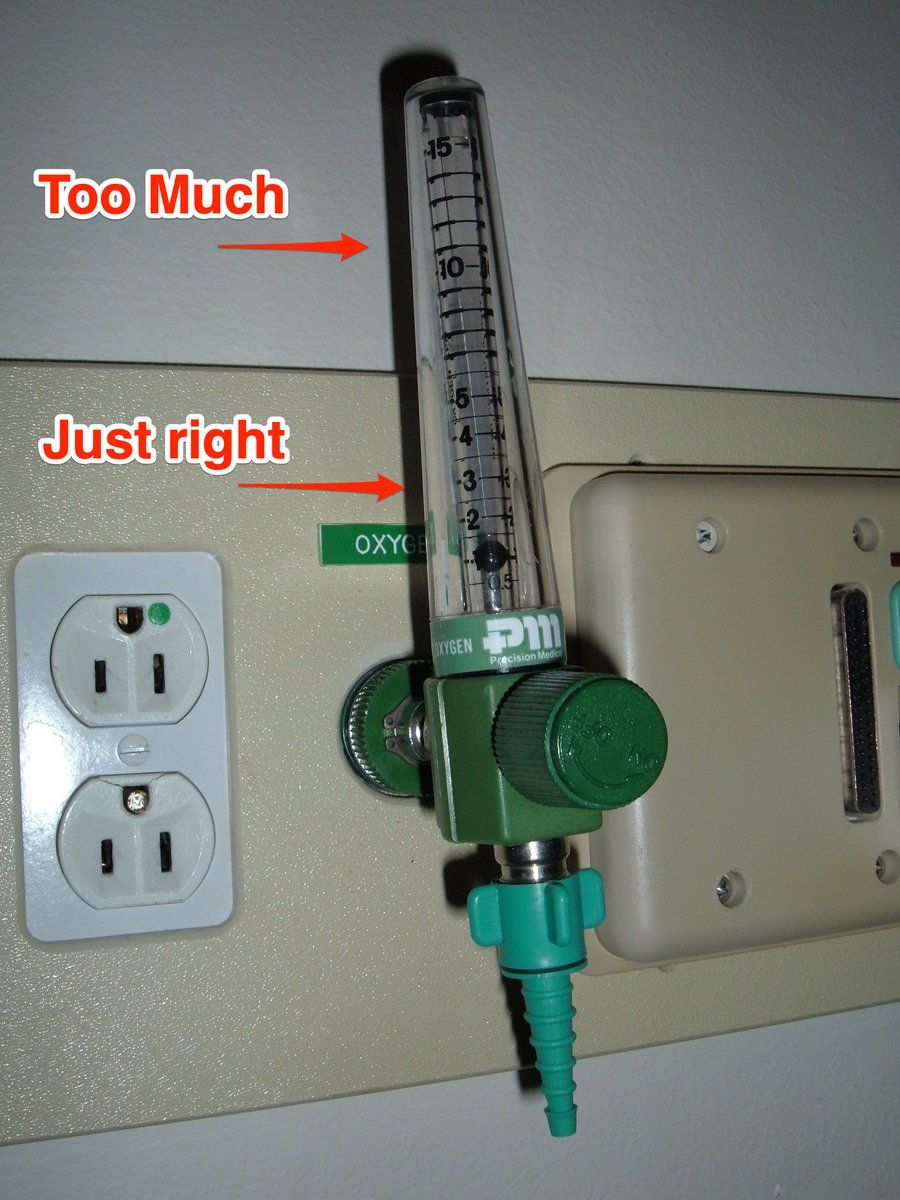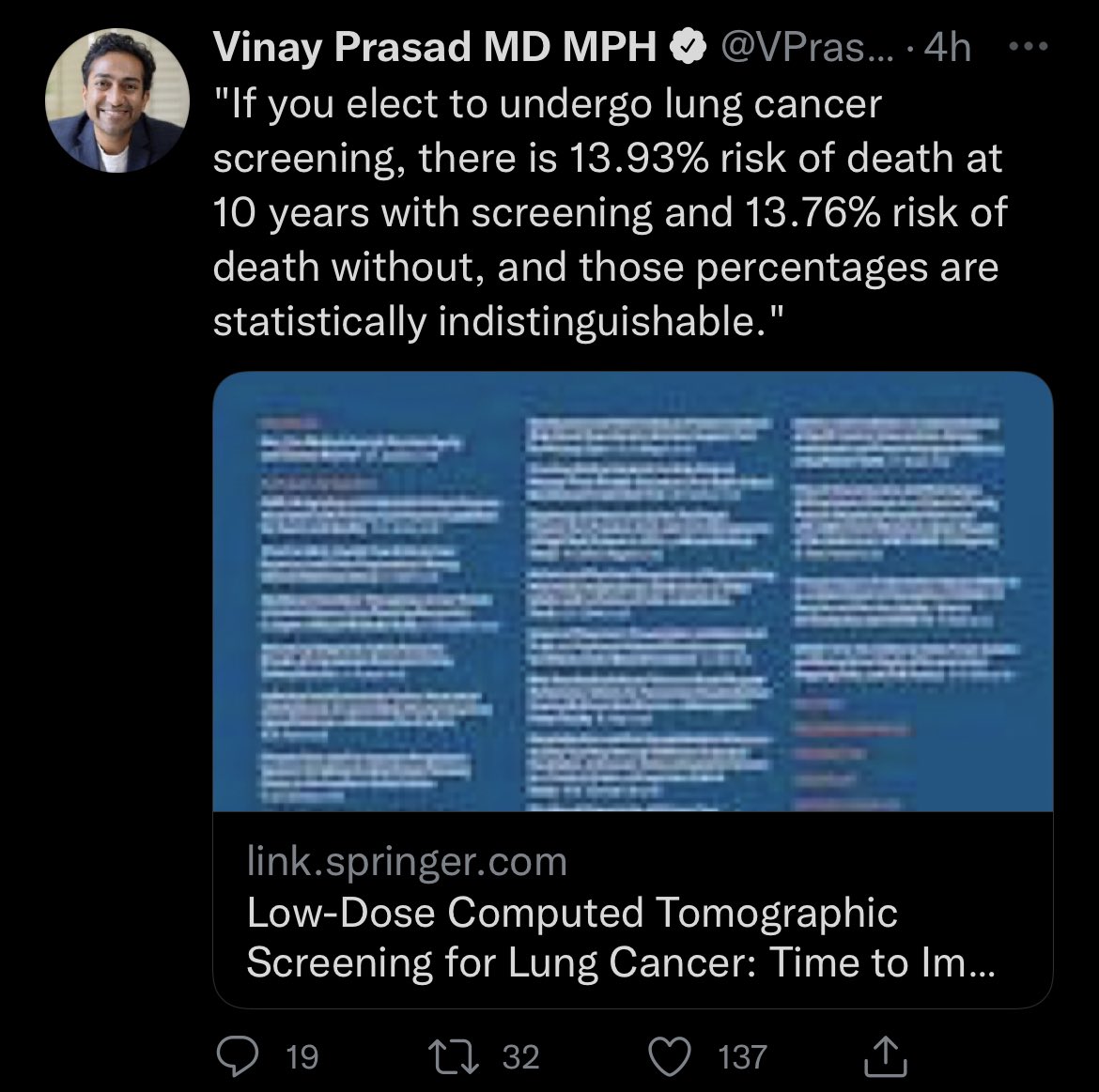
Here’s another pulmonary physiology question that *everyone* who gives O2 to patients ought to know:
What is the primary mechanism by which supplemental oxygen can increase PaCO2 in someone with severe COPD?
1/
What is the primary mechanism by which supplemental oxygen can increase PaCO2 in someone with severe COPD?
1/
This is a hard question! You probably learned that "its bad to give someone with COPD ‘too much’ O2 because they might stop breathing”
Turns out hypoxic respiratory drive causing apnea is a MYTH..but there is an important truth here:
A🧵on Oxygen induced hypercapnia!
2/
Turns out hypoxic respiratory drive causing apnea is a MYTH..but there is an important truth here:
A🧵on Oxygen induced hypercapnia!
2/

Every myth has a little kernel of truth:
In the 80s it was shown that giving people with severe COPD (GOLD stage IV) high flow oxygen (15 lpm) made their minute ventilation (VE) drop then return (almost) to normal, but PaCO2 rose significantly.
Why?
ncbi.nlm.nih.gov/pmc/articles/P…
3/
In the 80s it was shown that giving people with severe COPD (GOLD stage IV) high flow oxygen (15 lpm) made their minute ventilation (VE) drop then return (almost) to normal, but PaCO2 rose significantly.
Why?
ncbi.nlm.nih.gov/pmc/articles/P…
3/

Initially it was theorized that this increase in PaCO2 was due to loss of hypoxic respiratory drive. This is probably the story you were told in medical or nursing school.
The only problem is this isn't true!
👀 If we look close there are a few problems with this theory...
4/
The only problem is this isn't true!
👀 If we look close there are a few problems with this theory...
4/

PaCO2 should be inversely proportional to minute ventilation. If you double you VE you should (roughly) half your PaCO2.
But that's NOT what happened!
Ultimately VE fell by only ~5% (from 10 to 9.5 l/min) but PaCO2 increased by 35% (from 63 to 85 mmHg)!
What did we miss?
5/
But that's NOT what happened!
Ultimately VE fell by only ~5% (from 10 to 9.5 l/min) but PaCO2 increased by 35% (from 63 to 85 mmHg)!
What did we miss?
5/

Clearly the 5% decrease in minute ventilation (VE) can't possibly explain a 35% rise in PaCO2!
If we do the math, the change in minute ventilation can explain at most 4.8 mmHg of the ~22 mmHg rise in PaCO2.
MYTH busted! This must be more than just a change in ventilation!
6/
If we do the math, the change in minute ventilation can explain at most 4.8 mmHg of the ~22 mmHg rise in PaCO2.
MYTH busted! This must be more than just a change in ventilation!
6/

It turns out that in addition to carrying oxygen, Hemoglobin also carries carbon dioxide.
It does this 3 ways:
1. Dissolved as CO2 (10%)
2. Bound to hemoglobin as HbCO2 (30%)
3. Buffered as bicarbonate (60% of CO2)
CO2 + H2O --> H2CO3 --> H+ + HCO3-
7/
It does this 3 ways:
1. Dissolved as CO2 (10%)
2. Bound to hemoglobin as HbCO2 (30%)
3. Buffered as bicarbonate (60% of CO2)
CO2 + H2O --> H2CO3 --> H+ + HCO3-
7/

Hemoglobin picks up CO2 in the tissues (where it is unloading O2), and unloads CO2 in the lungs (where it is picking up O2).
For this reason, dexoygenated Hb is better at carrying CO2 & oxygenated Hb is not good at carrying CO2.
8/
For this reason, dexoygenated Hb is better at carrying CO2 & oxygenated Hb is not good at carrying CO2.
8/

For this reason, administration of high concentrations of Oxygen can "push" CO2 off of hemoglobin and into solution, increased PaCO2.
That's he Haldane Effect - the phenomenon where binding of oxygen to hemoglobin promotes the release of carbon dioxide (raising PaCO2).
9/
That's he Haldane Effect - the phenomenon where binding of oxygen to hemoglobin promotes the release of carbon dioxide (raising PaCO2).
9/

Although the Haldane effect is very real it's effect isn't huge; it increases the PaCO2 by about 10%.
This means Haldane can only explain about 6 mmHg of the 22 mmHg increase in PaCO2! This is an important contributor but it isn't explaining most of the rise in CO2.
10/
This means Haldane can only explain about 6 mmHg of the 22 mmHg increase in PaCO2! This is an important contributor but it isn't explaining most of the rise in CO2.
10/
Sidebar: this doesn't mean the Haldane effect is inconsequential.
If my PaCO2 rose from 40 to 44 mmhg I probably wouldn't notice.
But in someone who chronically retains CO2 this could be a big issue. Going from a PaCO2 of 80 to 88 mmHg could be enough to cause CO2 narcosis...
11/
If my PaCO2 rose from 40 to 44 mmhg I probably wouldn't notice.
But in someone who chronically retains CO2 this could be a big issue. Going from a PaCO2 of 80 to 88 mmHg could be enough to cause CO2 narcosis...
11/
So what causes O2 induced hypercapnea then?
Recall that different lung areas get differential ventilation. (This is especially true in people with parenchymal disease like COPD)
Fortunately the lung regulates blood flow, decreasing perfusion (Q) to poorly ventilated areas.
12/
Recall that different lung areas get differential ventilation. (This is especially true in people with parenchymal disease like COPD)
Fortunately the lung regulates blood flow, decreasing perfusion (Q) to poorly ventilated areas.
12/

But what if we provide 'too much' supplemental oxygen?
This can cause the loss of hypoxic vasoconstriction increasing perfusion to the poorly ventilated alveoli.
(Maybe a better term would be HYPERoxic vasodilation! h/t @sargsyanz for suggesting this perfect term!)
13/
This can cause the loss of hypoxic vasoconstriction increasing perfusion to the poorly ventilated alveoli.
(Maybe a better term would be HYPERoxic vasodilation! h/t @sargsyanz for suggesting this perfect term!)
13/

This - the loss of hypoxic vasoconstriction to poorly ventilated lung areas - turns out to be the primary reason for oxygen induced hypercapnea.
ncbi.nlm.nih.gov/pmc/articles/P…
14/
ncbi.nlm.nih.gov/pmc/articles/P…
14/

Bottom line:
Giving supplemental O2 to someone w/ severe COPD really *can* cause oxygen induced hypercapnea.
It occurs for three reasons:
1. Loss of hypoxic vasoconstriction --> worse V/Q matching (major reason)
2. Haldane effect
3. Decreased respiratory drive
15/15

Giving supplemental O2 to someone w/ severe COPD really *can* cause oxygen induced hypercapnea.
It occurs for three reasons:
1. Loss of hypoxic vasoconstriction --> worse V/Q matching (major reason)
2. Haldane effect
3. Decreased respiratory drive
15/15


• • •
Missing some Tweet in this thread? You can try to
force a refresh











